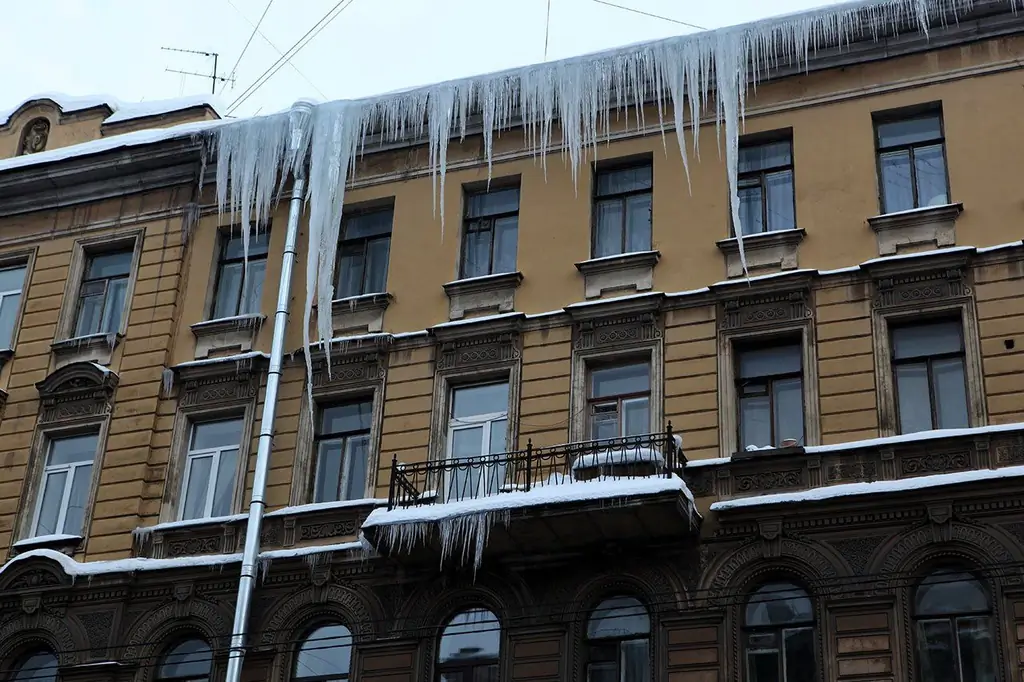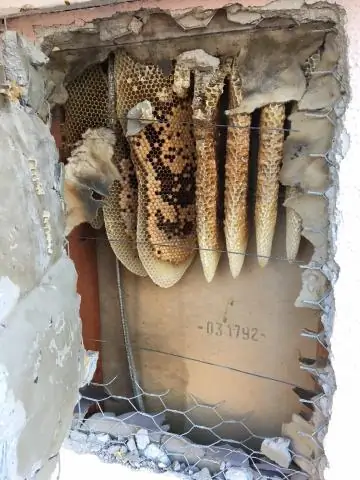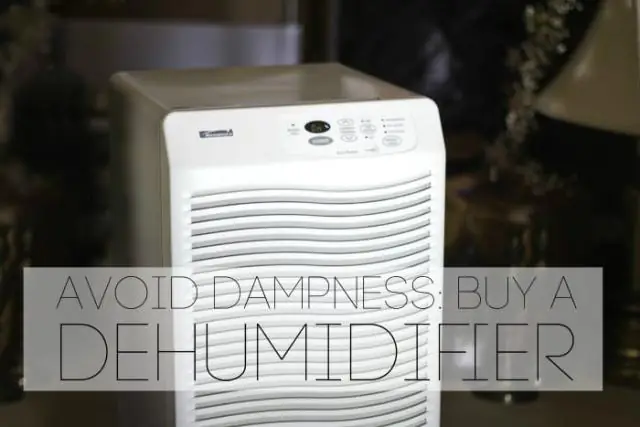
Table of contents:
- The reasons for the formation of icicles on the roof, how to deal with them and how you can prevent their appearance
- Reasons for the appearance of icicles on the roof
- How to get rid of icicles
- Safety requirements for being near the building and on its roof in winter
- How to prevent the formation of icicles and ice on the roof of the house
- Author Bailey Albertson [email protected].
- Public 2023-12-17 12:53.
- Last modified 2025-06-01 07:32.
The reasons for the formation of icicles on the roof, how to deal with them and how you can prevent their appearance

When icicles hang from the roof, they look beautiful and elegant, but they pose a serious danger. Due to temperature changes, small build-ups and whole blocks of ice can appear hanging from the eaves of houses. They pose a threat to people passing by, as well as cars and other objects near the walls of the building. Icicles falling from rooftops can damage electrical wires. To prevent the appearance of icicles on cold roofs, it is necessary to organize good ventilation, and if the attic is residential, then the roof must be insulated with high quality.
Content
- 1 Reasons for the appearance of icicles on the roof
-
2 How to get rid of icicles
2.1 Equipment for removing icicles from the roof
- 3 Safety requirements when being near the building and on its roof in winter
-
4 How to prevent the formation of icicles and ice on the roof of the house
4.1 Video: Installation of the roof de-icing system
Reasons for the appearance of icicles on the roof
There are several reasons that lead to the appearance of icicles on the roof of the house. Let's consider them in more detail.
- Poor thermal insulation of ceilings. If the house has a cold attic and the ceiling is poorly insulated, the warm air that comes from the room immediately enters the roof, because of which the lower layer of snow begins to melt. This leads to the appearance of icicles on the eaves and gutters.
- Poor ventilation of the attic space. If the ventilation system is poorly arranged in a cold attic, then due to the temperature difference inside and outside, the snow begins to melt.
- On a warm roof, the roofing cake is made incorrectly and the windows are poorly insulated. Heat leaks from the room, and if the thickness of the thermal insulation layer is insufficient, the snow on the roof begins to actively melt. With poor insulation of roof windows, the process of moisture formation begins around the window frame, which also leads to the formation of icicles.
- Natural factors. During thaws or with the approach of spring, the roofing material heats up in the sun and the natural melting of snow occurs, when the temperature drops, the water freezes and icicles appear.
- Disruption of the drainage system. When the gutters are clogged, moisture does not have time to be drained away and pours out of the gutters, where it immediately turns into icicles.
-
Incorrect operation. If ventilation ducts are closed in a cold attic or devices that emit heat are installed (air conditioner, heating pipes), local heating of the roofing material occurs.

Icicle formation due to poor insulation If the roof is poorly insulated, the lower layers of snow begin to thaw, as a result of which the resulting water flows down the slope and freezes on the eaves and in the gutters
How to get rid of icicles
If the reasons for the appearance of icicles were not eliminated in time, sooner or later the question arises of how to get rid of them. You can cope with this task in a private house with your own hands, and to get rid of icicles on multi-storey buildings it is best to involve specialists.
The use of modern technologies makes it possible to carry out such work with minimal human involvement, which significantly reduces the risk of injury. But this requires specialized equipment and trained personnel. When removing ice mechanically, one must be very careful, as there is a high risk of injury or falling off the roof. In this case, you also need to have certain experience and tools.

When performing work on the roof of the house, you must be extremely careful and be sure to use insurance
There are several basic options for removing ice and icicles on the roof.
-
Use special equipment. This includes laser or ultrasonic instruments, electrical heating cables, or chemical surface treatments.

Roof anti-icing system One of the most effective ways to remove icicles is to equip the roof with an anti-icing system.
- Invite industrial climbers. Trained and equipped personnel with the help of special tools can remove icicles from the roof of a building of any height, for them the complexity of the roof, the presence of a large number of architectural elements and other difficulties are not important.
- Do the work on your own. This method is suitable for residents of private one-story houses. Icicles can be knocked down using a solid pole of the appropriate size, while safety precautions must be followed so as not to get injured or damage nearby objects, cars, building windows, etc.
Equipment for removing icicles from the roof
In order to effectively deal with ice and icicles that appear on the roof of a large house, you need to have special equipment and tools. With their help, it will be not only easier and faster to work, but also safer.
Modern equipment used mainly in specialized companies includes the following devices:
- ultrasonic devices that break ice with a powerful pulse emitted in the appropriate range;
- laser devices that allow you to cut icicles using a directed beam of radiation;
- steam installations, in this case the icicles are cut off with a jet of steam;
- chemicals that quickly dissolve ice;
- electric pulse installations - inductors are installed on the roof surface, which, when voltage is applied, form a magnetic field and a pulsed eddy current, due to which a short-term deformation of the roof occurs and all icicles are removed.
When carrying out mechanical removal of icicles, depending on the type of building and whether the work will be done from the ground or from the roof of the building, the following tools will be needed:
-
scrapers. They have a T-shaped wood, metal, or plastic handle that is easy to pull and have a blunt metal plate at the end;

Scraper The telescopic handle of the scraper allows you to remove snow and icicles from a safe distance from the wall of the house
- shovel. In order not to damage the coating, it is better to use a plastic or metal shovel with a rubberized blade at the end;
- special axes. They should also not be sharp so that the roof of the building is not damaged during work;
- ice axes. They are used to remove those icicles that are located outside the roof;
- hooks and ropes to remove large icicles. With the help of such tools, they are fixed, after which they are cut down in small parts;
-
stairs. It must be strong and securely installed. A hydraulic lift can be used instead of a ladder;

Using a hydraulic lift to remove icicles In order to reach the icicles on the roof of a tall house, you can use a hydraulic lift
- long pole. With its help, you can shoot down icicles without approaching the building, and remove them at a safe distance;
- hacksaw, petrol or electric saw. These tools are used in the case of large icicles that cannot be easily knocked down;
- safety equipment. If work is carried out from the roof, it is imperative to use insurance, which must be strong and reliable in order to ensure the safety of people.
Safety requirements for being near the building and on its roof in winter
During thaws or in spring, when the snow is actively melting during the day and frosts at night, icicles begin to form actively on the roofs of buildings. In order not to get injured when an icicle falls from the roof, you must adhere to certain rules:
-
always pay attention to the presence of warnings issued by the municipal authorities, and independently look at the roofs of houses if your route runs under their walls;

Warning signs You cannot ignore the warning about the danger, so it is better not to walk in such places.
- if the site near the house is fenced, then you should not enter the prohibited areas, since work is being carried out there to remove ice from the roofs and you may be injured;
- if a utility worker is on the ground and coordinates the work of colleagues who are throwing snow and ice from the roof, then you should not come close to this place;
- if you use headphones in winter, keep in mind that you may not hear the warning about a possible danger and enter the danger zone;
- in winter, it is better not to approach a multi-storey building closer than 5 meters without any particular reason.
You need to clean the roof yourself, taking into account the following recommendations:
- such work cannot be performed alone, you definitely need a partner who can help in case of an emergency situation;
- the use of insurance is mandatory when such work is performed on the roof or from the stairs, even if the height of the building is not too high;
-
the insurance must be attached only to reliable roof elements - it cannot be attached to chimneys and ventilation ducts;

Safety requirements when working on the roof You cannot work alone on the roof, there must be a partner nearby, who, if necessary, can come to the rescue in time
- using a ladder, you can climb to a height of no more than 3-4 meters, in other cases, you need to use hydraulic lifts;
- if the angle of inclination of the stairs is more than 60 o, it is no longer possible to climb it;
- during work, you must use shoes with soft corrugated or rubber soles so that they slip less;
- it is impossible to work on the roof at a wind speed of more than 3 m / s, so be sure to check the weather forecast first
How to prevent the formation of icicles and ice on the roof of the house
It will be much easier and cheaper to prevent the appearance of icicles and ice than to constantly deal with them. There are several ways how to prevent the formation of ice on the roof, and each owner decides which one to choose.
The main condition under which ice on the roof will not form is to maintain a negative temperature of its surface. This is achieved by insulating the attic or under-roof space so that the heat from the house does not get onto the roofing material. In this case, the roof in winter will be covered with snow, and ice will not form on it.
The main methods for preventing the appearance of ice and icicles on the roof of a building are reduced to the following activities.
-
Elimination of places through which warm air enters the roof. A lot of heat is lost through the ceiling, if it is poorly insulated, and goes to the cold attic. If there is a residential attic, then it must be insulated even more carefully, since the walls of this room are in direct contact with the roofing cake. Most often, warm air comes out through the gaps near the chimney pipes, at the joints of gypsum plasterboards, etc. It is easiest to identify such places in winter. Just look at the roof and you will see where the snow melts more actively.

Elimination of heat loss spots If you eliminate the places of heat loss through the roof, icicles will no longer form on it.
- Providing the required thickness of thermal insulation materials. Experts recommend that the layer of fiberglass or mineral wool should be 30-35 cm. In addition to the thickness of the insulation, the correct installation is of great importance. Between themselves, the sheets should be tightly pressed so that there are no gaps anywhere. If the roof is insulated correctly, the possibility of icicles formation will be minimized: they will appear only when the surface is warmed up by the sun, but this is only for a few days.
- Creation of high-quality ventilation. With the help of such a system, warm air is effectively removed outside, and cold air takes its place. In the attic, the entrance holes are made above the cornice, and the weekend is near the ridge. In order for the ventilation system to work effectively, it must be correctly calculated. If your knowledge is not enough, then it is better to seek help from specialists. The total area of the inlets should be slightly larger than the area of the outlets.
- Installation of special vibrators. The vibrator can act on the rafter system or directly on the ice. In the first case, a small electric motor with an eccentric is installed on the rafters, which, during operation, creates minor vibrations with a frequency of 10-50 Hz, due to which the ice breaks and flies off the roof. Although such a device is small, it is sufficient to protect up to 200 m2 of roofs. Equipment operating in the ultrasonic range is used to influence the ice. At the output of the vibrator there is an electromagnet connected to a metal circuit. When the circuit vibrates, the ice breaks. But this technique is expensive and difficult to install.
- Snow holders. These elements do not prevent icicles from forming, but they do prevent large blocks of ice from falling off the roof. They detain them, they gradually melt, and the water flows from the roof.
- Antidepressant compounds. With their help, before the onset of cold weather, the roof is processed. These can be fluoroplastic, organosilicon compounds or a solution of synthetic rubber. After their application, the adhesion of ice and roof decreases, so the likelihood of ice formation is significantly reduced.
-
Electric heating. A special heat cable is installed on the lower edge of the roof, which does not allow ice to form. You will also have to spend a lot of money on the cable, and specialists are invited to install it. In order for the water to come off the roof, it is necessary to also heat the gutters. Two types of cables can be used for snow melting devices:
- self-regulating. Changes the power depending on the temperature outside, so it may differ in different areas, which saves energy. Such a cable does not heat up when overlapped, it is reliably protected from the negative effects of ultraviolet radiation, has a high resistance to damage, it can be mounted in sections of different lengths, but its cost is quite high;
- resistive. It has constant power along its entire length, is afraid of overlaps, and also has restrictions on the maximum and minimum length, but it costs much less.

Anti-icicle heating cable Laying the heating cable allows you to effectively combat icicle formation throughout the winter
Video: installation of a roof de-icing system
There is no one method that would completely eliminate the formation of icicles and ice on the roof. Natural factors cannot be influenced, so the snow on the roof will still melt. The implementation of the described measures will significantly reduce the rate of ice formation, therefore, if there are icicles, then they are small and unable to cause serious danger. If there is a need to clean the roof from snow and ice, then you already know how to do it correctly yourself.
Recommended:
How To Get Rid Of Wasps In The House: On The Balcony, In The Wall, In The Attic, Under The Roof And Elsewhere

Wasps are rather unpleasant insects, the neighborhood with which is fraught with at least bites. How to get rid of them and prevent them from appearing in the house?
How To Get Rid Of Rats In A Private House, Chicken Coop, Apartment And Other Premises - Using Various Methods To Get Rid Of Rodents

Reasons for the appearance of rats in the house. What methods, means to use in the fight against rats in various residential and non-residential premises. Preventive actions. Video
How To Get Rid Of Humidity And Dampness In An Apartment Or House, As Well As From The Accompanying Smell, How To Eliminate It And Useful Tips

Dampness and fungus in an apartment and a private house. The reasons for the appearance of excessive moisture, condensation, mold and how to eliminate them. Preventive measures. Instructions
How To Get Rid Of Mice In The Country, How To Scare Them Away, Folk Remedies To Combat Them

What are the best ways to deal with mice in the country. Description of the manufacture of traps, the use of poisons and ultrasonic repellents. Video
5 Things I Will Get Rid Of Before The New Year To Bring Happiness And Wealth Into The House, As Well As Get Rid Of Negativity

According to the old tradition, before the New Year, I get rid of 5 unnecessary things in order to let the positive energy of happiness and prosperity into my life
